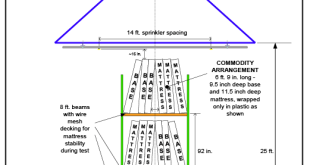TECHNICAL CHALLENGES
Can You Meet the Challenge?
AFSA’s Engineering & Technical Services Department staff present technical challenges here for you and your co-workers. These exercises are also excellent preparation for professional certification tests and may count as CEUs. Check with your certification organization. Answers to this issue’s questions will be presented in the next issue.
SEPTEMBER/OCTOBER ANSWERS
The following questions are based on NFPA 13, Standard for the Installation of Sprinkler Systems, 2022 edition.
1. What term is defined as “a water control valve that is held in the closed position by the system gas pressure exposed to the surface area on the air/nitrogen side of the clapper where such surface area is larger than the surface area on the water supply, with an intermediate chamber between the two surface areas that is open to atmosphere”?
A. Dry pipe valve
B. Mechanical deluge valve
C. Differential dry pipe valve
D. Mechanical dry pipe valve
Answer: C. Differential dry pipe valve. NFPA 13, 2022 Edition Section 3.3.235.4.1
2. What statement is correct for a 4-in. incoming riser check assembly?
A. The main drain valve size shall be 2 in.
B. The main drain valve size shall be 11/2 in. or larger.
C. The main drain valve size shall be 2 in. or larger.
D. The main drain valve size shall be based on the incoming static pressure. For static pressure less than or equal to 100 psi, a 2-in. valve is required. For static pressure over 100 psi, a 21/2-in. valve is required.
Answer: C. The main drain valve size shall be 2 in. or larger. NFPA 13, 2022 Edition Section 16.10.4
3. Listed indicating control valves shall not close less than _________ when operated at maximum possible speed from the fully open position?
A. 5 seconds
B. 15 seconds
C. 30 seconds
D. 60 seconds
Answer: A. 5 seconds. NFPA 13, 2022 Edition Section 7.6.1
4. Check valves shall be installed with flow in what direction?
A. In the vertical up or horizontal position in accordance with their listing.
B. In any direction their listing allows.
C. Any direction as long as the check valve incorporates a spring in the clapper assembly.
D. Only in the vertical up position in accordance with their listing.
Answer: A. In the vertical up or horizontal position in accordance with their listing. NFPA 13-2022 Edition, Section 16.9.4.4
5. A water control valve is defined as a valve that activates to allow water flow to a water-based fire protection system. Which of the following are examples of these valves?
A. Deluge, preaction, and dry
B. Deluge, dry, and control
C. Preaction, dry, and control
D. Deluge, preaction, check, dry, and control
Answer: A. Deluge, preaction, and dry. NFPA 13-2022 Edition, Section A.3.3.235.4
NOVEMBER/DECEMBER QUESTIONS
The following questions are based on NFPA 13, Standard for the Installation of Sprinkler Systems, 2022 edition.
1. When a waterflow test is used for the system design, how current must the waterflow test data be when submitted with the working plans?
A. Within 6 months of the working plan submittal date
B. Within 12 months of the working plan submittal date
C. Within 18 months of the working plan submittal date
D. Within 24 months of the working plan submittal date
2. Which of the following are the requirements for the pressure gauges used in a waterflow test?
A. Must be listed and calibrated within one year
B. Must be approved and calibrated within one year
C. Must be listed and calibrated within six months
D. None of the above
3. Who is required to provide the water supply information for the design of a sprinkler system, including any necessary adjustments?
A. Building owner
B. AHJ
C. Sprinkler contractor
D. Engineer of record
4. Which of the following is TRUE with regard to static pressure in a typical city water main?
A. It represents a condition of zero flow through the water main.
B. It represents a condition with normal domestic waterflow through the main, but zero hydrant flow.
C. It represents a condition with both normal domestic waterflow and hydrant flow.
D. It represents a condition with hydrant flow but zero domestic waterflow through the main.

 Sprinkler Age A Publication of the American Fire Sprinkler Association
Sprinkler Age A Publication of the American Fire Sprinkler Association



